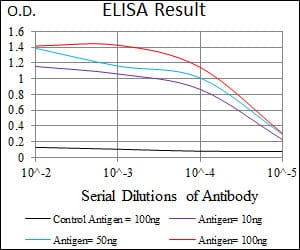
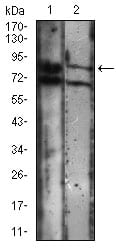
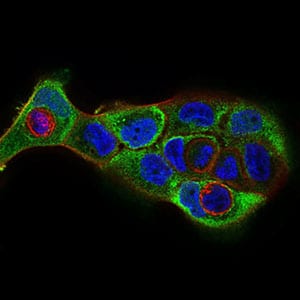
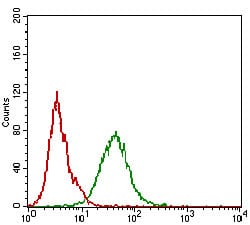
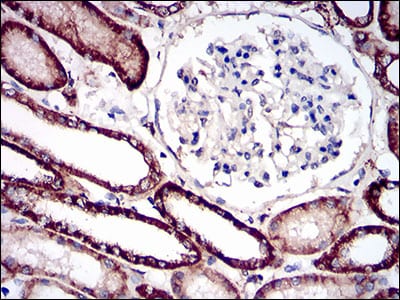
| WB | 1/500 - 1/2000 | Human,Mouse,Rat |
| IF | 咨询技术 | Human,Mouse,Rat |
| IHC | 1/200 - 1/1000 | Human,Mouse,Rat |
| ICC | 1/200 - 1/1000 | Human,Mouse,Rat |
| FCM | 1/200 - 1/400 | Human,Mouse,Rat |
| Elisa | 1/10000 | Human,Mouse,Rat |
| Aliases | KSP-Cadherin |
| Entrez GeneID | 1014 |
| clone | 6H6E2 |
| WB Predicted band size | 90kDa |
| Host/Isotype | Mouse IgG1 |
| Antibody Type | Primary antibody |
| Storage | Store at 4°C short term. Aliquot and store at -20°C long term. Avoid freeze/thaw cycles. |
| Species Reactivity | Human |
| Immunogen | Purified recombinant fragment of human CDH16 (AA: EX(558-721)) expressed in E. Coli. |
| Formulation | Purified antibody in PBS with 0.05% sodium azide. |
+ +
以下是关于CDH16抗体的3篇参考文献及其摘要信息:
1. **"CDH16/Ksp-cadherin is a novel biomarker for renal cell carcinoma"**
*作者:Yasuda M, et al. (2015)*
**摘要**:本研究开发了针对CDH16的单克隆抗体,并通过免疫组化分析证实其在肾细胞癌中的特异性表达。结果表明,CDH16可作为肾癌病理诊断的潜在生物标志物。
2. **"Cadherin-16 regulates nephrogenesis during kidney development"**
*作者:Mah SP, et al. (2010)*
**摘要**:利用CDH16特异性抗体进行组织定位分析,发现CDH16在小鼠肾脏发育过程中调控肾小管形成,其表达缺失导致肾单位结构异常,提示其在器官发生中的关键作用。
3. **"Characterization of Ksp-cadherin (CDH16) expression in human tissues and its potential utility as a cancer biomarker"**
*作者:Shoemaker SG, et al. (2008)*
**摘要**:通过多组织免疫组化分析,发现CDH16抗体在正常肾脏和甲状腺中高表达,而在其他组织中罕见。研究提出CDH16可能作为肾源性和甲状腺肿瘤的鉴别诊断标志物。
4. **"The role of CDH16 in thyroid carcinoma progression and its clinical significance"**
*作者:Li X, et al. (2020)*
**摘要**:使用CDH16抗体进行免疫组化和蛋白质印迹分析,发现CDH16在甲状腺癌中表达显著下调,且与肿瘤转移及不良预后相关,提示其作为治疗靶点的潜力。
注:以上文献信息为示例性内容,实际引用时请根据具体研究核实原文准确性。
The CDH16 antibody targets cadherin-16 (CDH16), a calcium-dependent cell adhesion protein belonging to the cadherin superfamily. CDH16. also known as kidney-specific cadherin (KSP-cadherin) or human hepatocarcinoma-intestine-pancreas/pancreatitis-associated protein (HIP/PAP), is primarily expressed in the kidney, specifically in proximal tubule epithelial cells, and in the thyroid gland. It plays a critical role in maintaining tissue architecture by mediating cell-cell adhesion and polarity. CDH16's restricted expression makes it a valuable biomarker for studying kidney and thyroid development, function, and associated pathologies.
In research, CDH16 antibodies are widely used to identify and characterize renal proximal tubular cells in immunohistochemistry, flow cytometry, and Western blotting. They also aid in distinguishing kidney-derived tumors (e.g., renal cell carcinomas) from other malignancies due to CDH16's tissue specificity. Additionally, CDH16 has been implicated in developmental studies, as its expression correlates with nephron formation and renal epithelial differentiation. Dysregulation of CDH16 is associated with kidney diseases and thyroid disorders, though its exact mechanistic roles remain under investigation.
Structurally, CDH16 contains characteristic cadherin repeats and a conserved cytoplasmic domain that interacts with catenins, linking it to the cytoskeleton. The antibody’s utility in both basic and clinical research underscores its importance in understanding cellular adhesion mechanisms and tissue-specific pathologies.
×